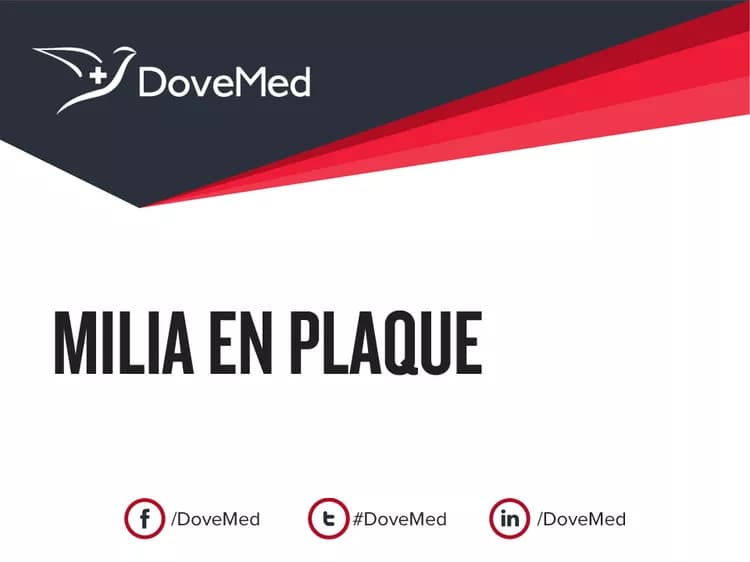
Milia en Plaque
What are the other Names for this Condition? (Also known as/Synonyms)
- MEP (Milia en Plaque)
What is Milia en Plaque? (Definition/Background Information)
- Milium is a benign condition that presents as a small cyst under the skin surface, commonly on the face. These cysts can occur in individuals of any age group and gender. They are usually multiple in numbers, and hence, called Milia (plural of Milium)
- Milia en Plaque (MEP) is an uncommon type of Milia that usually occurs as plaques in middle-aged women. A plaque is a broad, raised area on the skin; it is usually broader than it is high
- There are no identified causative factors for Milia en Plaque and the occurrence of these plaques cannot be prevented
- There are also no significant signs and symptoms associated with this condition, although they may not be cosmetically appealing, particularly as they occur on the face
- Milia en Plaque may not require any treatment in most cases. Also, in a majority of individuals, it may disappear spontaneously on its own. However, if treatment is necessary, the options may include topical creams, cryotherapy, laser therapy, and dermabrasion
- The prognosis is generally excellent for Milia en Plaque, since it is a benign condition
Who gets Milia en Plaque? (Age and Sex Distribution)
- Milia en Plaque is typically observed in middle-aged adults, though a wider age range of presentation may occur
- Both men and women are affected, but it is seen with a higher incidence in women
- There is no known racial, ethnic, or geographical preference
What are the Risk Factors for Milia en Plaque? (Predisposing Factors)
The risk factors for the development of Milia en Plaque include certain health conditions such as:
- Lichen planus
- Pseudoxanthoma elasticum (PXE)
- Discoid lupus erythematosus (DLE)
It is important to note that having a risk factor does not mean that one will get the condition. A risk factor increases ones chances of getting a condition compared to an individual without the risk factors. Some risk factors are more important than others.
Also, not having a risk factor does not mean that an individual will not get the condition. It is always important to discuss the effect of risk factors with your healthcare provider.
What are the Causes of Milia en Plaque? (Etiology)
- The exact cause of Milia en Plaque occurrence is unknown. However, certain health conditions are known to influence its development
- It is not an infectious condition and it does not spread from one individual to another through direct or indirect contact
- It has not been observed that dietary factors contribute to the development of this condition
What are the Signs and Symptoms of Milia en Plaque?
In majority of the cases, Milia en Plaque is asymptomatic and presents no significant signs or symptoms.
- Frequently, the condition manifests as multiple plaques that may be observed all over the body
- They are usually present on the head and neck region, especially around the eyelids and cheeks
- These plaques may be several centimeters in size
- Solitary plaques are not commonly observed
- There may be itching sensation in the affected region
How is Milia en Plaque Diagnosed?
- Milia en Plaque may be diagnosed based on their presentation, a clinical examination, and comprehensive medical history
- The examination of the skin by a dermatologist using a special magnified lens (dermoscopy) may be undertaken
- Mostly, there is no necessity for a skin biopsy to diagnose the condition
- Specific tests may be undertaken based on the presence of underlying conditions
Many clinical conditions may have similar signs and symptoms. Your healthcare provider may perform additional tests to rule out other clinical conditions to arrive at a definitive diagnosis.
What are the possible Complications of Milia en Plaque?
There are no significant complications that occur due to Milia en Plaque.
- Some individuals face cosmetic issues due to the appearance of multiple plaques (on the face), in which case an appropriate treatment may be recommended
- Complications may occur from underlying health conditions
How is Milia en Plaque Treated?
The treatment measures for Milia may include the following:
- Topical retinoids
- Laser ablation therapy
- Cryotherapy
- Chemical peels
- Dermabrasion
- Administration of antibiotics (such as doxycycline) in some cases
In many individuals, the condition is self-limiting and the plaques may regress and disappear within a few weeks. Also, no treatment may be necessary in a majority of individuals, since Milia en Plaque is a benign condition with no serious signs and symptoms.
How can Milia en Plaque be Prevented?
- Current medical research has not established a method of preventing Milia en Plaque
- However, if there are certain underlying disorders that contribute towards its development, then treating these disorders may help in the treatment and early cure of Milia en Plaque
What is the Prognosis of Milia en Plaque? (Outcomes/Resolutions)
- In a majority of cases, Milia en Plaque is asymptomatic or mild that subsides on its own without the requirement for any treatment, within a few weeks or months. However, the healthcare provider may undertake to regularly monitor the condition
- The prognosis is generally excellent with suitable treatment
Additional and Relevant Useful Information for Milia en Plaque:
- Cleaning the skin too hard with strong chemicals or soaps may aggravate the condition. Care must be taken avoid strong soaps and chemicals that could potentially worsen the condition
- Scratching the affected areas or picking the cysts must be completely avoided
Related Articles
Test Your Knowledge
Asked by users
Related Centers
Related Specialties
Related Physicians
Related Procedures
Related Resources
Join DoveHubs
and connect with fellow professionals


0 Comments
Please log in to post a comment.